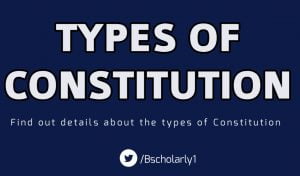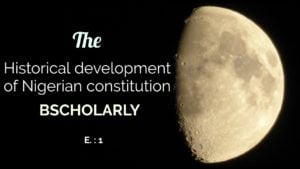The 1st of October, 1960 is a very significant date in the history of Nigeria. It was in that year that Nigeria got her independence and became free from colonial leadership of the British. Even though the country was not totally free at that point, the 1960 constitution of Nigeria was referred to as the independence constitution because it made Nigerians autonomous to a very large extent. Well, today, i will be discussing the features of the 1960 Independence Constitution of Nigeria. In other words, i will be explaining the characteristics of 1960 constitution, pointing out some of important features that made it the independent constitution.
Consequently, If you have been searching the internet to know the features of the 1960 constitution of Nigeria, or how the constitution made Nigeria independent of colonialism, i enjoin you to continue reading till the end. Trust me, you are not going to regret reading this work.

Also read:
- Major Types of Constitution you should know
- Differences between federalism and unitary system of government
- Differences between rigid and flexible constitution
- Differences between military and domestic government
Nigeria before the 1960 Independence Constitution
From the 23rd of May to 26th of June 1957, there was a constitutional conference in London arranged mainly to correct the deficiencies of Lyttleton Constitution of 1954. The decisions reached in the conference was for establishment of full regional self-government for the East and West in 1957 and for the North in 1959.
Some other decisions that was agreed upon in the conference was that the office of the prime minister of Nigeria should be established, the federal legislature would comprise two houses, the senate and house of representative, that a commission of inquiry should be set up to consider the complaints of the minorities in each region, that the house of representative would have 320 members distributed according to the population of each area in the country, that the police should remain under federal control. There was also a proposal to create more regions in Nigeria before independence. However, the constitution was able to implement self -government for the East and West on 8 August 1957 and the North in 1959.
On the 2nd of September 1957, Alhaji Abubakar Tafawa Balewa was appointed Nigeria’s first prime minister by the governor-general. The regional imbalance with the three main ethnic- groups, the Hausa, in the North, Igbos in the east and Yoruba in the west created undue fears, for the east and west were threatened by the predominant population of the south. There was also the fears of the minorities on the other hand.
The fears of the minorities in a smaller regional arrangement led to the creation of a commission of enquiry under Sir Henry Willink to look into the matter and to propose means of allaying the fears. The minorities commission led by Sir Henry Willink submitted its report in 1958. This prompted another constitutional conference in Lagos.
The conference discussed the report of the commission set up in 1957, that is the fears of the minorities. The commission failed to recommend the creation of regions. Instead, it recommended the incorporation of fundamental human rights in a future constitution to protect Nigerian citizens. It was the agglomeration of the constitutional conferences that led to the constitutional development of 1960 which is the independence constitution. The independence constitution was a federal constitution.

Also read:
- Major Achievements of military rule in Nigeria
- The the positive and Negative Impacts of Colonialism in Nigeria
Top 11 Characteristics/Features of the 1960 Independence Constitution of Nigeria
The following are the features of the 1960 independence constitution:
1. The federal legislature was made a bicameral legislature. It consisted of House of Representatives which was the lower house and the senate which was the upper house. Every bill passed must be assented to by the Governor-General before it becomes law. The Governor-General was a representative of the Queen of England who was still Head of State of Nigeria. The House of Representative had 305 members. The senate had 44 members.
2. The federal executive was made up of the Prime Minister and a number of important Ministers. The prime minster was the head of the federal Executive. It was the duty of the Governor – General to appoint whoever appeared to him to command majority support in the House of Representative as Prime Minister. All the members of the federal executive must be members of the house of representative. The system whereby the executives are also members of the legislature is called Parliamentary system of government.

3. All regional parliaments were made of two houses: House of Assembly which was the lower and House of chiefs which was the upper house. All members of the House of Assembly were elected directly by the electorate. House of Chiefs was made up of a number of important traditional rulers.
4. Provisions were included in the constitution for the creation of more regions or states and boundary adjustments of existing ones.
5. The regional Executive was made up of premier and a number of important Ministers. The leader of the party having majority support in the House of Assembly was appointed by the Regional governor as premier. The Governor also appointed the Regional Ministers on the advice of the premier. All members of the Executive must be members of the House of Assembly.
6. The constitution provided for three lists known as the Executive List, Concurrent List and Residual List. Only the Federal government can deal with items in the Exclusive List. Items on this included the Armed forces, Currency, Foreign affairs, Police, customs and Excise, Migration and Aviation. Both the federal and Regional Governments were to deal with items in the concurrent List. However, where Federal and Regional laws clash, the federal lawsd would supersede.

7. The constitution provided for the establishment of the Judicial Service commission. The appointment, discipline and promotion of judges were the responsibility of the commission. This was meant tom protect the judiciary from political interference. Under this constitution, appeals from the supreme court of Nigeria lie to the privy council in London.
8. It also included fundamental human rights in line with decisions at the 1958 constitutional conference.
9. Qualifications for Nigerian citizenship was defined.
10. It retained the federal structure with the regions having residual powers.
11. The governor general was made the ceremonial head of state.

Also read:
- Are lawyers liars? See the truth answer here
- Examination malpractice in Nigeria: Causes, Effects and Solutions
- Best 10 universities to study law in Nigeria
- Advantages and disadvantages of an unwritten constitution
Wrapping up:
From the above, it is apparent that the 1960 constitution really made Nigeria independent to a very large extent even though not completely. According to many scholars, this particular constitution was was what prompted Nigerians to seek for a more independent constitution in 1963. In fact, even current 1999 constitution of Nigeria is has some provisions that was picked from the 1960 constitution showing fully well that it is a product of the independence constitution.
Hope this article was helpful? Well, i did like to here from you if you have any question or contribution to this topic. Thank you very much for reading.

Edeh Samuel Chukwuemeka, ACMC, is a lawyer and a certified mediator/conciliator in Nigeria. He is also a developer with knowledge in various programming languages. Samuel is determined to leverage his skills in technology, SEO, and legal practice to revolutionize the legal profession worldwide by creating web and mobile applications that simplify legal research. Sam is also passionate about educating and providing valuable information to people.
Pls who is the secretary colony that headed the 1960 constitution